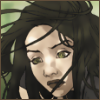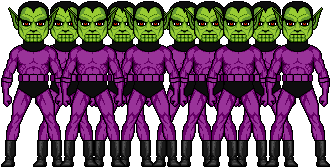 |
|
MARVEL CHECKLIST
Der ULTIMATIVE LEITFADEN durch das
MARVEL UNIVERSUM
|
|
|
|
 |
|
Anfang
zurück
weiter
Ende
|
| Autor |
Beitrag |
Vao
SUPERBANANE

Beiträge: 5647

|
 Erstellt: 26.01.08, 14:38 Betreff: Reviews: The Black Diamond Detective Agency ( First Second ) (2008)
drucken
Thema drucken weiterempfehlen Erstellt: 26.01.08, 14:38 Betreff: Reviews: The Black Diamond Detective Agency ( First Second ) (2008)
drucken
Thema drucken weiterempfehlen
|
|
|

von Eddie Campbell.
BDDA ist eine Comic-adaptation eines Screenplays, dessen Film nocht nicht gemacht wurde. Etwas was im letzten Jahr im Comic-biz stark in Mode war, besonders bei Virgin.
In der Geschichte die am Ende des 19. Jahrhundert spielt, geht es um John Hardin, der nach einer Zugexplosion als Hauptverdächtiger gilt und deshalb von der BDDA verhaftet wird. Seine Frau ist spurlos verschwunden.
Nachdem Hardin die Flucht aus der Zelle gelingt, muss er sich nicht nur vor dem Geheimdeinst und der BDDA verstecken. Er versucht auch gleichzeitig seine Frau als auch die wahren Handlanger wiederzufinden.
Ein Comic, das Spannung und eine interessante Intrige bietet. Die meisten Plotelemente sind altbacken und schon oft gesehen, stören jedoch nicht. Sadie hat mir an dieser OGN am meisten gefallen. Campbells Zeichnungen sind einfach nur schön.
9/10
[editiert: 07.02.08, 13:04 von Kaine]
|
|
| nach oben |
|
 |
Vao
SUPERBANANE

Beiträge: 5647

|
 Erstellt: 26.01.08, 14:40 Betreff: Re: Reviews: The Black Diamond Detective Agency ( First Second )
drucken
weiterempfehlen Erstellt: 26.01.08, 14:40 Betreff: Re: Reviews: The Black Diamond Detective Agency ( First Second )
drucken
weiterempfehlen
|
|
|
eine Kritik vom Blogger Jog:
The Black Diamond Detective Agency
Out in stores today, from First Second, 142 color pages for $16.95.
Sitting here now around the tail end of the publisher’s third wave of releases (the fourth wave has been announced, by the way), totaling an even 18 books with all heads counted, The Black Diamond Detective Agency is a unique in two major areas: (1) it’s largely a straightforward, ‘realistically’-rendered action/mystery comic; and (2) it’s a comics adaptation of a pre-existing movie screenplay, written by C. Gaby Mitchell and handled by producer Bill Horberg. The movie has not yet been made, but Eddie Campbell’s comic is all ready to go.
The book is also unique among the artist’s works. Campbell is no stranger to adaptation, mind you. After all, his prior book for First Second, The Fate of the Artist, concluded with an adaptation of an O. Henry short story, which the artist seamlessly folded into his mix of themes and intuitive visual cues. Prior to that, we’ve had the works eventually collected as A Disease of Language, transformations of Alan Moore’s spoken-word performances into swirls of word and picture. However, Campbell has never quite matched his style with the quick-moving thrills of a streamlined slice of action movie entertainment before - obviously there were action sequences in various bits of the Bacchus saga, or the likes of Batman: The Order of Beasts, but they’d always been contained in a Campbell-created capsule of austere intrigue and mythic conversational play, one where he could set the parameters right from the start. Here, the parameters had to be reconfigured.
Thus, we have the saga of John Hardin, a haunted man of obvious mystery, and the murderous train bombing that obliterates the peace of his life and summons the detectives of the title, one of those private investigation services that could grow to the size of an army back around the close of the 19th century, which is where the book is set. The Black Diamond detectives think Hardin exploded that train, and maybe facilitated the disappearance of a very important mystery safe traveling therein. The detectives are at a bit of a loss themselves - they’re always clashing with federal authorities, like the Secret Service, and don’t even have access to the basic knowledge of what the stolen goods they’re chasing actually are. But then, the truth was as flexible a thing back then as it was now.
As will come to no surprise to those who’ve read First Second’s Free Comic Book Day giveaway, Hardin eludes the detectives’ grasps, and goes on the run. Have I mentioned his beloved wife has also left him, at just the same time as the bombing? Neither of them were quite what they seemed to be, and throughout Our Anti-Hero’s journey, several additional transformations take place. Hardin adopts two additional names. At different times, he poses as two other members of the book’s cast. At one point -- and this would no doubt be the trailer’s ‘hook’ if this were to become a major motion picture -- he actually joins the very detective agency that’s chasing him, utilizing their smarts and resources to accomplish his own ends, which after all does involve solving the mystery.
All of this is possible through the uncertainty of memory, identity and technology, a theme that Campbell ably carries through this comics incarnation of the material. The book is divided into two chapters, plus a prologue and epilogue. The chapters are titled “Frames” and “Secrets.” That first one is particularly pregnant with possibility - Hardin is apparently ‘framed’ for a crime he didn’t commit, he constantly stares at the world through the frames of glasses (a classic comics symbol for secret identity), and he moves freely thanks to the low quality of the drawings that frame his image for the newspapers. Eventually, Hardin and the detectives run in with a lovely, alcohol-soaked sketch artist and photographer, the only person around who seems capable of harnessing something evoking the truth in the frames of her own creations (an interesting character indeed for Campbell, who himself has worked as a courtroom artist, sketching the likenesses of the accused, for occasional use on the news).
Also: a comic book features many frames (panels), and Campbell smartly plays with the properties of the form whenever possible, whether he’s opening the first chapter by framing Hardin behind a window frame (the rest of his home a cutaway to emphasize the fragile state of his security), or providing a variant of the prologue’s opening splash at the end of the first chapter, to signify a certain realization. Extreme anger, violence and fear is signified by the solid color red, which recurs throughout the book by spilling from characters’ mouths in lieu of dialogue or simply dominating the page, as in that early explosion sequence (which you can view via First Second’s online preview, in case you missed it). It’s really a very attractive book in general, with many pages caked in all the dust and dirt one would expect from the man who coated From Hell in soot and grime, and in fine, subtle color. The character designs are often excellent, with Hardin’s shifting visage in particular seeming cool, dangerous and pathetic all at once with its shaggy facial hair, rumpled hat, and gleaming green glasses.
But there are also qualms, many of which seem to stem from the transition between mediums. This is an extremely compressed work, albeit quite swiftly moving, careening from event to event by interspersing stretches of wordless observation and action with thickets of verbiage. Text narration occasionally dominates pages, and dialogue sometimes stuffs characters into the bottom corner of panels. The result is an oddly jittery pace, a start-and-stop structure that may well jar readers that prefer a smoother overall word and picture balance, although I do think the book as a whole is more balanced than individual sequences might suggest.
One suspects that this may be Campbell’s means of coping with the structure of the original screenplay, just as one contemplates whether many of the supporting characters would have popped as more resonant in a film, where actors might more easily make the personages on display more recognizable through their performances - as it is on the comics page, not all of the smaller characters quite emerge as fleshed, which is a problem when the story as a whole seems plainly meant to operate for a stretch as an ensemble, everyone-works-together sort of story.
Even Campbell’s visual style proves a bit troublesome during those big action sequences, although there’s some pleasure to be had. The trick is, while Campbell’s delicately rendered scenery is perfectly good for mood-enhancing conversation, it doesn’t have quite the exactness necessary to afford a reader the sense of spatial direction that an intense chasing/shooting sequence requires. As a result, some of Campbell’s action bits can be rather difficult to follow on first blush, so long as they’re ensconced in typical comics ‘realism,’ although once you’ve got your bearings there’s some great bits of flourish on display, with frames rocking and tipping with gunfire, and tiny panels breaking off from the main action to signify the paths of bullets and running men across a large, white space that stands in for the environment as a whole.
By the end of this book, it seems everyone is lost in a blank place. I won’t spoil any plot movements - there’s an awful conspiracy at work, of course, along with some fairly improbable coincidences. But the story winds up in what seems to be a series of calculated anticlimaxes. Villains are finally seen, and fade just as quickly. Romantic sparks fly, and promptly die. All of the Good Guys seemingly get what they think they want, only to realize that maybe they didn’t want it at all. The path of the obsessed, go-the-distance hero seems quietly sad, even foolish. The book’s onrushing theme of uncertainty concludes with something that’ll no doubt bring From Hell to mind for many readers - the birth of the 20th century. But it’s not so much madness that breaks out, but a new evolution in humankind’s capacity to fool one another, and to undermine the fantasies of black & white morality and firm ‘sides’ in a conflict. Even though they think it’s a new thing, the impression is given that people have been that way for a while.
Ah, but it’s nothing that can’t quite be coped with. Who knows how the screenplay wrapped up, but the book concludes with a final moment of surrender to the celebratory nature of the unknown. A glass raised, in wholly Campbellian fashion.
http://joglikescomics.blogspot.com/2007/06/fates-almost-didnt-allow-but-then.html
|
|
| nach oben |
|
 |
|
powered by carookee.com - eigenes profi-forum kostenlos
Design © trevorj
|

 US-NEWS
US-NEWS  REVIEWS
REVIEWS  AWARDS
AWARDS  EINKAUFSLISTEN
EINKAUFSLISTEN 




 Login
Login Suche
Suche Chat
Chat
